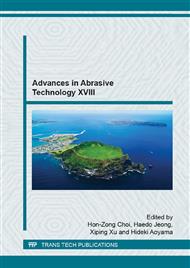p.299
p.305
p.311
p.317
p.321
p.327
p.333
p.338
p.343
Polishing of Aluminum Alloy Using Photocatalyst and Cathilon Dye under Utraviolet Irradiation
Abstract:
A fundamental study on finishing aided by an ultraviolet ray (generally mashining:referred to as U-RAMR) was conducted to evaluate its applicability to the polishing of aluminum alloy. Qualitative analysis with X-ray photoelectron spectroscopy (XPS) was used to estimate the chemical reaction induced on Al surfaces that were immersed in some solutions. Inductively coupled plasma spectroscopy (ICPS) was employed to quantitatively analyze the amount of oxidized/dissolved Al, Mg and Fe. The following conclusions were obtained by investigation of the aluminum alloy polishing process. Aluminum does not dissolve in TiO2-solution, whereas a small amount of Al dissolves into cathilon dye solution. Although only a small amount of Al dissolves in TiO2-cathilon dye solution in the absence of UV irradiation, the amount of Al dissolved increases slightly under UV irradiation with the formation of oxide, nitrogen oxide and nitride on the Al surface. In addition, a small amount of an aluminum chloride dissolves into TiO2-cathilon dye solution. An Al alloy (A5052) surface was made flat by polishing with TiO2-cathilon dye slurry under UV irradiation.
Info:
Periodical:
Pages:
321-326
Citation:
Online since:
January 2016
Authors:
Price:
Сopyright:
© 2016 Trans Tech Publications Ltd. All Rights Reserved
Share:
Citation:


